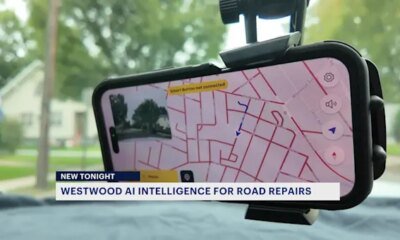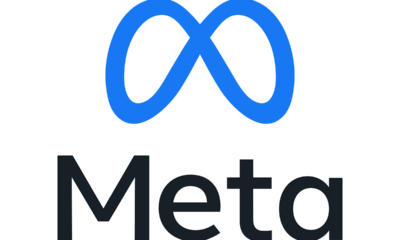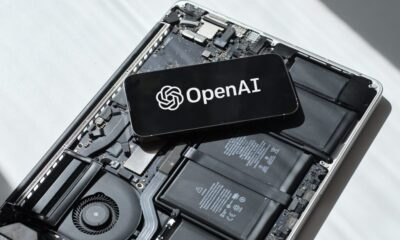Education
Artificial intelligence is here to stay, so let’s teach it in class

Editor’s Note: This article was written for Mosaic, an independent journalism training program for high school students who report and photograph stories under the guidance of professional journalists.
As a 16-year-old high school student living in the Bay Area, I notice artificial intelligence being used around me daily. At my school, I’ve seen students submitting AI-generated work as their own, rather than taking the time to research, write and truly understand content.
Teachers see this and fear that students will go out in the real world and not know how to think critically without consulting a machine first. They see how it has already created an overreliance on shortcuts, weaker problem-solving skills and lower writing ability in their students. In response, many teachers have banned AI from their classrooms.
I’ll be honest: sometimes I use AI in school, too. By asking ChatGPT to help me explain the meaning of a piece of text or asking it to identify flaws in my writing, I intentionally use AI to help me learn. But when some of my peers use it to generate their entire assignments, it leads teachers to see any use of AI — whether it be productive or exploitative — as a lazy way to cheat, and it makes me feel guilty to use it at all.
It’s understandable why many educators feel this way, and researchers agree. For example, in a 2024 study published by the journal Societies, a sampling of 666 people showed that younger participants reported a higher use of AI tools but displayed lower critical-thinking skills.
However, AI isn’t going away. Other studies show that the use of AI in the workplace and in education is rising. A 2025 Gallup poll of U.S. employees showed those who frequently use AI multiple times a week nearly doubled, from 11% to 19% in two years. It’s only becoming more integrated in the world we live in, and without being taught AI literacy in school, the future feels uncertain.
Completely wiping AI out from classrooms doesn’t work in the long term, because students still find ways to move around it and misuse it for their assignments. It’s easy for them to adapt by using content humanizers like Bypass GPT or AIHumanize to avoid being detected. Banning it does not solve the problem.
A ban also erases the opportunities that AI can give students to do better in school. For example, an English teacher might have students generate an essay using AI, then have them critique its writing style and argument, or compare it to their own essay to identify areas that can be improved.
Khanmigo, an AI platform developed by Khan Academy, can give students more practice problems in math when they struggle with a particular concept, and can work with them to learn, rather than handing them answers.
This is a chance for educators to teach students how to use AI responsibly — not as a substitute for creative and critical thought, but as a tool to support them in academics instead. AI is still a developing technology that presents ethical issues, like its substantial environmental impact and potential biases that can be introduced by algorithms. It’s also known to not always be reliable for credible information and research.
But I rarely see these issues being discussed around me — it’s a missed opportunity for teachers to encourage digital literacy and for students to engage with a technology that will ultimately shape our world.
Sophie Luo is a member of the class of 2027 at Irvington High School in Fremont.
Originally Published:
Education
Empowering learners with AI from classrooms to career

Image credit: Adobe Stock/Comeback Images.
As generative AI continues to reshape education, Adobe sees AI not as a replacement for thinking, but as a catalyst — for accelerating ideation, enhancing creativity, and fostering deeper engagement in learning. We’re energized by the White House’s Pledge to America’s Youth to invest in AI education as a critical step in putting essential AI and creative skills in the hands of the next generation of learners and we are proud to contribute to this critical area.
Adobe is providing the approximately 50+ million K-12 students and teachers across the United States with free access to Adobe Express for Education — Adobe’s all-in-one creativity app with generative AI tools designed for the classroom. Adobe is also providing professional development and training for all U.S. educators to help them better equip their students with AI skills.
The world of work is changing fast, and AI skills are no longer a nice-to-have; they’re a must-have. That’s why Adobe is committed to preparing learners of all ages for the AI-driven world we live in now.
Why AI skills matter more than ever
Early access to AI skills is essential to ensure students aren’t left behind in a rapidly evolving workforce. Embedding these skills now builds a more innovative future. The data is compelling: According to Lightcast, AI-skilled roles offer a 28 percent salary premium, with demand growing across industries — including 800 percent growth in generative AI roles in non-tech industries and a 200 percent increase in education-related roles since 2022.
At Adobe, we see firsthand how AI is already revolutionizing the creative process. Adobe Firefly is supercharging creativity and productivity with features such as Generative Fill and Generative Extend. Acrobat Studio is revolutionizing documents for the AI era, turning static files into conversational knowledge hubs, with a personalized AI Assistant for deeper insights. And Adobe Express is bringing AI-charged ideation and creation to everyone. AI can help consumers and business professionals work more efficiently and raise the bar of what they create.
Adobe is committed to empowering learners at every stage
For decades, Adobe has been dedicated to supporting creativity and digital literacy in education. Adobe’s commitments as part of the White House Pledge to America’s Youth are part of our broader mission to empower learners of all ages and in all stages of learning to ideate, create and collaborate with AI.
Through programs like Adobe Creative Campuses, we partner with universities to bring creative education and design thinking into higher-ed curricula. For specialists investing in their careers, the Adobe Certified Professionals program offers formal credentialing and certification in Adobe tools like Photoshop, Illustrator, Firefly and more. The Adobe Digital Academy is preparing learners with creative and technical skills and is focused on AI literacy, content creation, and digital marketing. The program aims to reach 30 million next-generation learners and educators by 2030.
Last year, Adobe invested $100 million to expand access through product donations, scholarships, and partnerships with schools, nonprofits, and platforms like Coursera. Learners gain hands-on experience with Adobe Express, Acrobat, and Creative Cloud, developing in-demand skills that help them stand out in an increasingly digital world.
I was honored to take part in the White House Task Force meeting on the AI Education Pledge, which underscored the urgency of equipping every learner with the knowledge and tools to thrive in this new era. And as part of the Pledge to America’s Youth, students and educators interested in participating in the Presidential AI Challenge will also be able to use Adobe’s AI tools, including Adobe Express, in their submission.

At the White House Task Force Meeting on Artificial Intelligence Education.
Demystifying AI in the classroom
The positive impact of bringing AI into the classrooms is already being felt as Adobe’s AI-powered creative tools make learning more engaging and collaborative. Using Adobe’s AI tools, which are designed with safety and user control at their core, teachers are seeing deeper learning and increased motivation. For example, teachers using Adobe Express to integrate generative AI into hands-on projects found that the curriculum boosted student creativity, prompted ethical discussions about the application of AI, and sparked teamwork and engagement beyond traditional assignments.

Source: Leanlab Education x Adobe educator survey, spring 2025.
Building together
To fully realize the potential of AI in education, we’re committed to working alongside governments and education leaders to empower both teachers and students with AI skills and capabilities and help train an innovative, future-ready workforce that can thrive in the digital age.
Educators can learn more about using free Adobe tools and curriculum resources to unlock creative potential in your classroom.
We urge policymakers to invest in early AI skilling and equitable access for all students. Learn more about the commitments Adobe and others have made to the White House AI Education Pledge and join us in supporting a future where every learner is prepared for the opportunities ahead.
And we urge everyone to share stories of AI in the classroom. Let’s inspire each other and build a brighter future together.
Education
New push for AI as Education Minister Erica Stanford announces curriculum changes

Education Minister Erica Stanford
Photo: RNZ / Samuel Rillstone
The government has announced a number of new secondary school subjects and a new emphaisis on artificial intelligence it says will help prepare young people for the jobs of the future.
Education Minister Erica Stanford said those working on the changes will investigate having a new Year 13 subject on Generative AI “for later development”.
“With the rapid development of AI, students will also be able to learn about and use generative AI in a range of subjects. This may include learning about how digital systems work, machine learning, cybersecurity, and digital ethics.”
Stanford said the new subjects, being developed for the Years 11 to 13 curriculum, reflect the growing importance of science, technology, engineering and mathematics, often referred to as STEM.
The subjects include: automative engineering, building and construction, and infrastructure engineering.
“Students will be able to specialise in areas such as earth and space science, statistics and data science, and electronics and mechatronics. There will also be a range of new specialist maths subjects including further maths.
“When our young people leave school, we want doors to open for them whether they’re going to tertiary study, learning a trade, or heading straight into work. These refreshed subjects will provide students with choice, purposeful pathways and opportunities for specialisation that set them up for success,” Stanford said in a statement.
It was vital students had access to “innovative and dynamic subjects” that would help the country’s future, she said.
Other new subjects include: civics, politics and philosophy, Pacific studies, Te Mātai i te Ao Māori and music technology.
Te Marautanga o Aotearoa will be resourced with a first ever detailed curriculum in te reo Māori as well as new subjects including new Tātai Arorangi (Māori traditional systems of Earth and Sky), Te Ao Whakairo (Māori carving) and Te Ao Māori subjects.
The subjects are planned to be phased in from 2028.
Sign up for Ngā Pitopito Kōrero, a daily newsletter curated by our editors and delivered straight to your inbox every weekday.
Education
White House Secures Commitments From Orgs for AI Education
-

 Business2 weeks ago
Business2 weeks agoThe Guardian view on Trump and the Fed: independence is no substitute for accountability | Editorial
-
Tools & Platforms4 weeks ago
Building Trust in Military AI Starts with Opening the Black Box – War on the Rocks
-

 Ethics & Policy2 months ago
Ethics & Policy2 months agoSDAIA Supports Saudi Arabia’s Leadership in Shaping Global AI Ethics, Policy, and Research – وكالة الأنباء السعودية
-

 Events & Conferences4 months ago
Events & Conferences4 months agoJourney to 1000 models: Scaling Instagram’s recommendation system
-

 Jobs & Careers2 months ago
Jobs & Careers2 months agoMumbai-based Perplexity Alternative Has 60k+ Users Without Funding
-

 Podcasts & Talks2 months ago
Podcasts & Talks2 months agoHappy 4th of July! 🎆 Made with Veo 3 in Gemini
-

 Education2 months ago
Education2 months agoMacron says UK and France have duty to tackle illegal migration ‘with humanity, solidarity and firmness’ – UK politics live | Politics
-

 Education2 months ago
Education2 months agoVEX Robotics launches AI-powered classroom robotics system
-

 Funding & Business2 months ago
Funding & Business2 months agoKayak and Expedia race to build AI travel agents that turn social posts into itineraries
-

 Podcasts & Talks2 months ago
Podcasts & Talks2 months agoOpenAI 🤝 @teamganassi





















